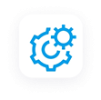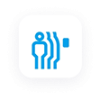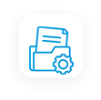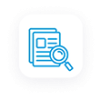When the Covid-19 pandemic began to rapidly spread across the world in 2020, effective sanitization became a huge priority among both businesses and the community. This caused the demand for the deployment of robots for tasks such as automatic disinfection. As a result, the mobile robotics industry is now expected to reach $23 billion in 2021.
Here are the vital ways robotics are being used to disinfect and help maintain healthy and safe workplaces during the pandemic.
Arenas
Sports and entertainment arenas are home to vast areas of space, not to mention tens – if not hundreds – of thousands of seats. The manpower needed to manually disinfect an arena would be beyond many companies’ budgets, and even then, it would take several days to complete the job. It comes as no surprise that drones are now being used in this ground-breaking way.
Containing a device that sprays disinfectant, several of these drones are flown around the arena to sanitize every square inch of the place. The disinfectant is fed to them through a hose from a tank on the ground.
Not only can an entire arena be sanitized and safe for another event within just a day, but using robotics in this way also prevents employees from being directly exposed to the virus.
Offices
While many offices may have closed during the pandemic, sending their workforce to work from home and isolate, some remained open, or are starting to be filled with employees once more. In addition to the daily cleaning done by janitorial staff, autonomous robots are being utilized to sanitize office spaces on a continual basis to limit human exposure and help prevent virus outbreaks.
The autonomous robots come in two distinct types, including those that spray disinfectant and those with UV lighting capabilities. While entire areas are sanitized, autonomous robots utilized for office cleaning also pay close attention to disinfecting desks, as well as high-touch surfaces such as door handles, light switches, and handrails.
The LiDAR and obstacle detection sensors built into these robots ensure that they can detect the presence of other objects or barriers, and if necessary, reroute themselves to avoid collisions.
Schools
In the pre-pandemic world, schools turned to a small army of workers to sweep, mop, and disinfect it from floor to ceiling when needed. However, after the global pandemic hit, schools must now ensure the most rigorous forms of daily sanitization and leave no room for error if they want to keep their students and staff safe.
As a result, autonomous robots are now also being used within educational facilities. Unlike human beings, they follow the same route every single time.
Obstacle detection sensors and 2D/3D mapping are important, as they give the robot a detailed understanding of its assigned area’s layout. Additionally, sensors create sophisticated spatial recognition and prevent collisions with students or staff, as well as other objects or obstacles in its way.
Hospitals
Hospitals are another area which is benefiting immensely from the use of autonomous robots for disinfection. Not only is it extremely important to protect health professionals working on the front line against coronavirus, but also to maintain the health and safety of patients whose immune systems are already compromised.
Within hospitals, there are meticulous compliance standards that have been put in place to ensure the highest level of sanitization. Using automated metrics, many cleaning robots are able to transmit data about how much surface area has been cleaned to ensure that these compliance standards are constantly being met.
Additionally, utilizing robots to sanitize isolated patient areas can prevent further spreading of the disease to cleaning personnel.
Transportation
Even during a global pandemic, transport such as trains, buses, and planes are still required to allow people to commute. Without constant disinfecting, however, they too carry a high risk of passengers transmitting Covid-19 to fellow travelers.
Thankfully, cleaning robots are being used to sanitize public transport too. They do this by spraying a fine mist of disinfectant over surfaces, as well as exposing the areas to ultraviolet light to kill 99.9999 percent of bacteria, including the novel coronavirus.
This is another area where sensors used for area mapping, spatial recognition, and navigation on autonomous mobile robots are vital for them to perform these tasks.
Cleaning robots are becoming an increasingly popular option for protecting the community from Covid-19 and other health risks. Here at Hokuyo, our high-quality sensors allow autonomous robots to keep critical environments like arenas, offices, schools, hospitals, and transportation clean and safe. Contact our team today to learn how our sensors can help your business.

 Factory Automation
Factory Automation Logistics Automation
Logistics Automation Process Automation
Process Automation Crane Collision Avoidance
Crane Collision Avoidance LiDAR/Obstacle Detection
LiDAR/Obstacle Detection Safety Laser Scanners
Safety Laser Scanners Optical Data Transmission
Optical Data Transmission Hot Metal Detectors
Hot Metal Detectors Laser Distance Sensor
Laser Distance Sensor Blog
Blog Whitepapers
Whitepapers Case Studies
Case Studies Infographics
Infographics